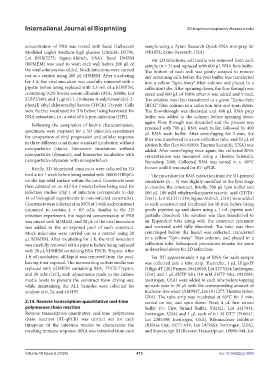Page 421 - IJB-10-6
P. 421
International Journal of Bioprinting 3D-bioprinted respiratory disease model
concentration of PR8 was mixed with basal Dulbecco’s sample using a Zymo Research Quick-RNA miniprep kit
Modified Eagle’s Medium-high glucose (DMEM; D5796, (#R1054; Zymo Research, USA).
Lot RNBJ5275; Sigma-Aldrich, USA). Basal DMEM For 2D infections, cell media was removed from each
(bDMEM) was used to wash each well before 200 µL of sample (n = 3) and replaced with 600 µL RNA lysis buffer.
the viral solution was added. Mock infections were carried The bottom of each well was gently scraped to remove
out as a control using 200 µL bDMEM. After incubating any remaining cells before the lysis buffer was transferred
for 1 h, the viral inoculum was carefully removed with a into a yellow “Spin-Away” filter column and placed in a
pipette before being replaced with 2.5 mL of a bDMEM, collection tube. After spinning down, the flow through was
containing 0.2% bovine serum albumin (BSA; A8806, Lot saved and 600 µL of 100% ethanol was added and mixed.
SLBZ3340), and 1 µg/mL L-[(toluene-4-sulphonamido)-2- The solution was then transferred to a green “Zymo-Spin
phenyl] ethyl chloromethyl ketone (TPCK)-Trypsin. Cells IIICG” filter column in a collection tube and spun down.
were further incubated for 5 h before being harvested for The flow-through was discarded and 400 µL RNA prep
RNA extraction, i.e., a total of 6 h post-infection (HPI). buffer was added to the column before spinning down
again. Flow through was discarded and the process was
Following the completion of bioink characterization, repeated with 700 µL RNA wash buffer, followed by 400
specimens were prepared for a 3D infection experiment µL RNA wash buffer. After centrifuging for 2 min, the
for comparison of viral progression and cellular response filter was transferred to a new collection tube, and 52 µL of
in three different conditions: standard incubation without elution buffer (Lot 00165805; Thermo Scientific, USA) was
nanoparticles (static), bioreactor incubation without added. After centrifuging once again, the collected RNA
nanoparticles (dynamic), and bioreactor incubation with concentration was measured using a Thermo Scientific
nanoparticles (dynamic with nanoparticles). Nanodrop 2000. Collected RNA was stored in a -80°C
Briefly, 3D-bioprinted constructs were cultured in 3D freezer until it was used for RT-qPCR.
media for 1 week before being seeded with 50000 HBEpCs The procedure for RNA extraction from the 3D-printed
on the top solid surface within the pool. Constructs were constructs (n = 3) was slightly modified at the lysis stage
then cultured on an ALI for 2 weeks before being used for to dissolve the construct. Briefly, 500 µL lysis buffer and
infection studies (day 1 of infection corresponds to day 100 µL 100 mM ethylenediaminetetraacetic acid (EDTA;
14 of biological experiments in non-infected constructs). E6511, Lot SLCH11239; Sigma-Aldrich, USA) were added
Constructs were infected at an MOI of 1 with each construct to each construct and incubated for 10 min before being
estimated to contain 4 × 10 cells. Similar to the 2D gently pipetted up and down using a 1 mL pipette until
5
infection experiment, the required concentration of PR8 partially dissolved. The solution was then transferred to
was mixed with bDMEM, and 20 µL of the viral inoculum an Eppendorf tube along with the construct remnants
was added to the air-exposed pool of each construct. and vortexed until fully dissolved. The tube was then
Mock infections were carried out as a control using 20 centrifuged before the liquid was collected, transferred
µL bDMEM. After incubating for 1 h, the viral inoculum to a yellow “Spin-Away” filter column, and placed in a
was carefully removed with a pipette before being replaced collection tube. Subsequent procedures remain the same
with 20 µL bDMEM containing BSA TPCK-Trypsin. After as described above for 2D infections.
1 h of incubation, all liquid was removed from the pool, For RT, approximately 5 ng of RNA for each sample
leaving it air-exposed. The surrounding culture media was was collected into a tube strip. Thereafter, 1 µL OligodT
replaced with bDMEM containing BSA, TPCK-Trypsin, (Oligo dT [20] Primer, 18418020, Lot 2577004; Invitrogen,
and 20 mM CaCl , with adjustments made to the culture USA) and 1 µL dNTP Mix (10 mM dNTP Mix, 1912584;
2
media levels to prevent the construct from drying out, Invitrogen, USA) were added to each tube before topping
while maintaining the ALI. Samples were collected for up each tube to 20 µL with the corresponding amount of
analysis at 6, 24, and 48 HPI. nuclease-free water (AM9937, Lot 1511277; ThermoFisher,
USA). The tube strip was incubated at 65°C for 5 min,
2.14. Reverse transcription-quantitative real-time cooled on ice, and spun down. Next, 4 µL first strand
polymerase chain reaction buffer (5× First Strand Buffer, Y02321, Lot 2417931;
Reverse transcription-quantitative real-time polymerase Invitrogen, USA) and 1 µL each of 0.1 M DTT (Y00147,
chain reaction (RT-qPCR) was carried out for each Lot 2385398; Invitrogen, USA), Ribonuclease Inhibitor
timepoint of the infection studies to characterize the (RNAse Out; 10777-019, Lot 2475863; Invitrogen, USA),
resulting immune response. RNA was extracted from each and Superscript III (Reverse Transcriptase, 18080-044, Lot
Volume 10 Issue 6 (2024) 413 doi: 10.36922/ijb.3895

